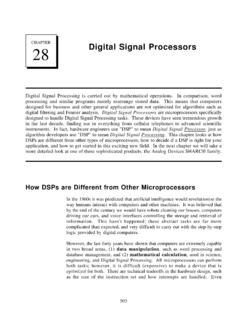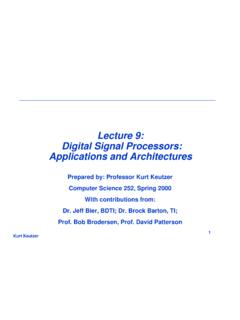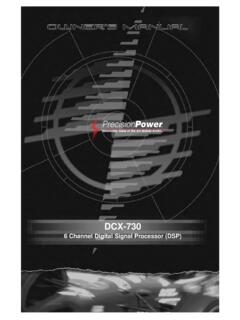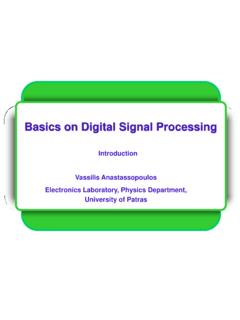Transcription of Digital Signal Processing Application on the Texas ...
1 Digital Signal ProcessingApplication on the Texas Instrument c6748 ProcessorVersion OsmalskyjandJean-Jacques EmbrechtsOctober 15, 2014 Contents1 Introduction to Digital Signal Introduction .. Processors architecture .. c6748 processor .. Architecture .. Interrupts .. OMAP L-138 Experimenter Board .. 102 Development environment:Code Composer First connection to the EVM .. Create a project .. 143 Input / Data format .. Polling .. Interrupts .. Direct Memory Access (DMA) .. Volatile variables .. Syntax .. Use .. Peripheral registers .. Interrupt service routines .. 224 Finite Impulse Response (FIR) Filters .. Windowed-sinc filters .. Windowed-sinc filters design.
2 Recursive Filters .. Narrow-band filters .. IIR filters structures .. Direct Form I Structure .. Direct Form II Structure .. Cascade structure .. 305 Frame-based Signal Frame-based vs Sample-based Processing .. Direct Memory Access .. Architecture .. DMA transfer .. DMA in practice .. Ping-Pong buffering .. Project organization .. Frame-based convolution .. Overlap-Add .. 406 Fast Fourier Discrete Fourier Transform .. Fast Fourier Transform .. Forward FFT .. Inverse FFT .. FFT in practice .. FFT Convolution .. 45 Chapter 1 Introduction to Digital IntroductionDigital Signal Processors (DSP) are specific processors used for Signal Processing . Digitalsignal Processing is used in many areas such as sound, video, computer vision, speech anal-ysis and synthesis, etc.
3 Each of these areas need Digital Signal Processing and can thereforeuse these specific processors. DSPs are found in cellular phones, disk drives, radios, print-ers, MP3 players, HDTV, Digital cameras and so on. DSPs take real world Signal likevoice, audio, video, temperature, pressure, position, etc. that have been digitized usingan analog-to- Digital converter and then manipulate them using mathematical are usually optimized to process the Signal very quickly and many instructions arebuilt such that they require a minimum amount of CPU clock optimization of the processors include hardware multiply accumulate (MAC) ca-pability, hardware circular and bit-reversed capabilities, for efficient implementation ofdata buffers and fast Fourier transforms (FFT), and Harvard architecture (explained inSection ).
4 One specificity of DSPs are their MAC operation (Multiply ACcumulate).Once a Signal has been digitized, it is available to the processor as a serie of numerical val-ues. Digital Signal Processing often involves the convolution operation, which correspondto a serie of sums and products. On a general CPU, each of these instruction takes morethan one clock cycle. However, DSP s MAC operation performs a product and a sum inone clock cycle, allowing thus faster Signal Processing . Another specificity of DSPs is theirability to access more than one memory address in one cycle. This allows the processor toread an instruction and the corresponding data simultaneously. This is an improvementover general are typically very similar to microcontrollers. They usually provide single chip com-puter solutions integrating on-board volatile and non-volatile memory as well as a rangeof peripheral interfaces.
5 They moreover have a small footprint, making them ideal for em-bedded applications . In addition, they tend to have low power consumption requirements,which makes them suitable for portable applications , for example in cell phones, or in general, Digital Signal processors are used primarily in real-time applications . Real-timeprocessing means that the Processing must be done within a fixed time period, usually3 CHAPTER 1. INTRODUCTION TO Digital Signal PROCESSORS4 Figure : Von Neumann architecturesynchronized with an external peripheral, for example an analog-to- Digital converter. Thiscourse focuses on real-time Digital Signal Processing and each examples used in the coursedeal with that real-time document is organized as follows. This first chapter introduces DSPs architectures,and in particular the Texas Instrument c6748 DSP architecture, which is used in thiscourse.
6 Chapter2 describes the Texas Instrument integrated development environment(IDE) and the setup of Code Composer Studio to start programming the DSP. In Chapter 3,several input / output schemes are described to access the audio samples. Chapter 4introduces notions of filtering and presents the two most used filters, which are the FiniteImpulse Response (FIR) filters and the Infinite Impulse Response (IIR) filters. The chapteralso describes some useful implementations of those filters. Direct Memory Access (DMA)is explained in Chapter 5. DMA is used to transfer blocks of samples between the codec andthe memory without any CPU intervention, which is useful for many frame-based signalprocessing algorithm. Finally, Chapter 6 details the use of the Discrete Fourier Transform(DFT) in the DSP, as well as the Fast Fourier Transform (FFT) reference books are used for this course.
7 The first one isDigital Signal Processing andApplications with the OMAP-L138 eXperimenter[8], by Donald Reay, and the second one isReal-Time Digital Signal Processing from MATLAB to C with the TMS320C6x DSPs[10],by Thad B. Welch, Cameron Wright and Michal G. Processors architectureThere are two types of architectures used in processors:Von Neumanarchitecture, andHarvardarchitecture. In the first one, programs and data are stored in the same memoryzone, as showed in Figure In that kind of architecture, an instruction contains theoperating code (opcode) and the addresses of the the second type of architecture, there are two memories: one for the program, and onefor the data. Both memories are separated and are accessed via separated buses, as shownin Figure That organization allows to read an instruction and the data simultaneously,which improves the overall performance of the microprocessors usually make use of the Von Neuman architecture.
8 However,DSPs tend to use the Harvard architecture which is more suited for real-time DSPs use a modified Harvard architecture, in which there is one external bus for thedata, and one external bus for the addresses, like the Von Neuman architecture. However,the DSP contains two internal distinct data buses and two distinct addresses buses. TheCHAPTER 1. INTRODUCTION TO Digital Signal PROCESSORS5 Figure : Harvard architecturetransfer between the external and internal buses are performed using time is the case in some Texas Instrument processors (C6000 serie), in particular, this isthe case of the c6748 processor used in this c6748 ProcessorThis course uses a Texas Instrument OMAP-L138 processor , containing a c6748 DSP pro-cessor and an ARM9 processor in the same chip.
9 We only make use of the DSP part ofthe chip. The c6748 is based on Texas instruments very long instruction word (VLIW)architecture. This processor is well suited for numerically intensive algorithms. The in-ternal program memory is structured so that a total of eight instructions can be fetchedevery cycle. The c6748 has a clock rate of 375 MHz and is capable of fetching eight 32-bitinstructions every1/375 MHz or ns. The processor includes both floating-point andfixed-point architectures in one c6748 includes 326 kB of internal memory (32 kB of L1P program RAM/cache, 32 kBof L1D data RAM/cache and 256 kB of L2 RAM/cache), eight functional units composedof six ALUs and two multiplier units, an external memory interface addressing 256 MB of16-bit mDDR SDRAM, and 64 32-bit general purpose registers.
10 In addition, the OMAP-L138 features 128 kB of on-chip RAM shared by its c6748 and ARM9 processor ArchitectureIn this section we give an brief overview of the architecture of the c6748 processor . Thissection is an excerpt of the c6748 Datasheet [3]. Detailed documentation can be foundin [3]. The architecture of the CPU can be seen in Figure C674x CPU consists of eight functional units, two register files, and two data paths,as shown in Figure The two general-purpose register files (A and B) each contain 3232- bit registers for a total of 64 registers. The general-purpose registers can be used fordata or can be data address pointers. The data types supported include packed 8-bit data,packed 16-bit data, 32-bit data, 40- bit data, and 64-bit data.














